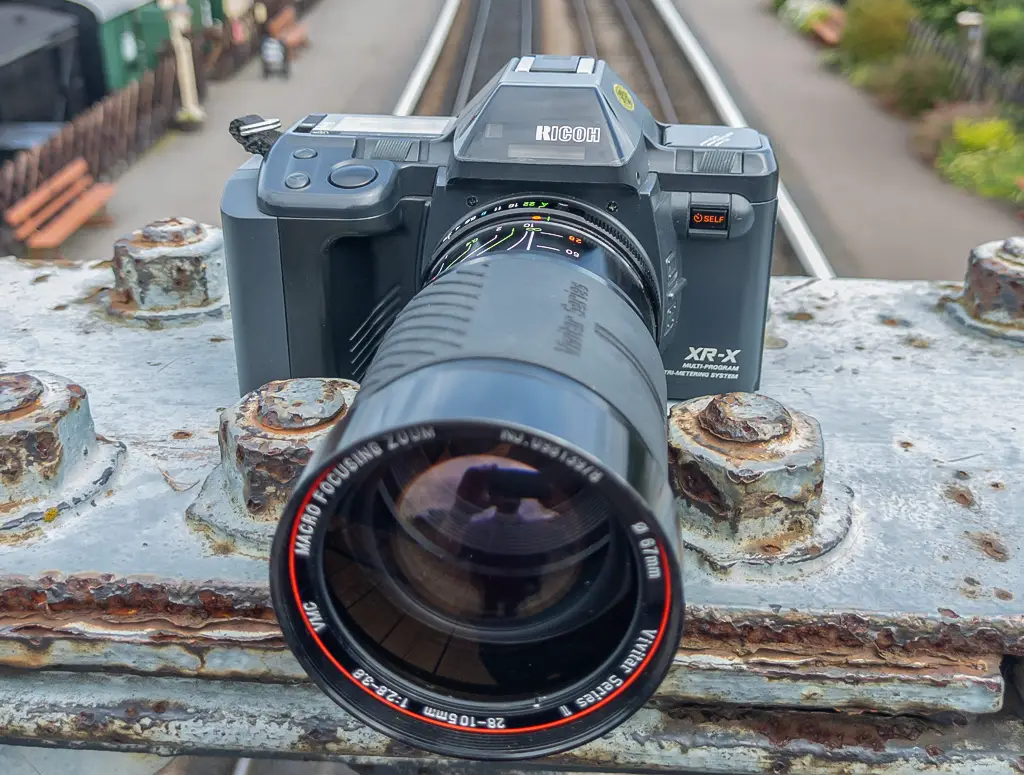I wanted to see how effective this mid-Eighties body and lens combination would be as a walkabout camera. Theoretically, the wide zoom range and program mode would enable me to capture images near or far at a moment’s notice, and the auto-wind would make me ready for the next shot immediately.
This is from an era when development of 35mm SLRs went from evolutionary to revolutionary. Some had autofocus. Buttons and LCD displays started to replace dials. Built-in powerwinders started to replace manual wind levers. Ricoh were still flogging the last of the KR and XR series of conventional cameras. They needed to move their range to another level, in the same way that Canon had done in moving from the A-series to the T-series.
The result, in 1987, was the XR-X (XR-M in the US market). It was a completely new and ergonomic design in dark grey plastic. The whole of the front of the pentaprism hump is a tinted clear visor, reminiscent of the ED-209 robot from the RoboCop movie (which came out in the same year).
It retains compatibility with all Pentax K lenses. Ricoh didn’t (or couldn’t?) licence the Pentax PK-A system of electrical contacts on the mount, that enable aperture control for full-program operation. Instead they came up with their own ‘Ricoh pin’ contact in a different position on the mount, and a range of lenses with a ‘P’ setting on the aperture ring. Just don’t try putting one on a Pentax autofocus DSLR, because the Ricoh pin is at the same position as the focus screw-drive coupling. There’s a risk that you won’t be able to get it off again.
One of the better contemporary lenses was this Vivitar one-touch zoom from their premium Series 1 range. It’s relatively fast, but not so much as to make it uncomfortably big and heavy. Like some other vendors, Vivitar hedged their bets and put both the PK-A contacts and the Ricoh pin on some of their lenses.
The camera works best in bright daylight, because the LCD display inside the viewfinder is backlit naturally from the light coming through the prism hump. In dark conditions, pressing the button to engage depth-of-field preview also turns on a viewfinder backlight bulb for a few seconds.
I loaded it with Kodak Gold 200 and took it out for a trip around North Norfolk a few weeks ago, starting with steam trains at Weybourne Station. The focal length range was ideal, and being a one-touch zoom it was quick and easy to compose and focus. I left the exposure controls on Program, but the three-position slide switch in front of the LCD display shifts the program between three modes: PD Program for a greater depth of field, normal P Program, and PA Program for faster shutter speeds. It adds just enough versatility to make you feel you’re still in control. For some shots of a locomotive chuffing past, I put the power-winder on ‘Continuous’ mode for the full Duran Duran Girls On Film sound effect. This was fun!
After a while I checked the frame counter so I could plan where to go next. 33. Oops. It’s quite easy to get carried away. Perhaps I’m a little too used to being able to rattle off a thousand shots a day with a DSLR. Change of plan then. I finished the roll at the station, and once it had taken the 36th frame it immediately power-rewound the film. Suddenly it sounded more like a Moulinex blender and the whirring noise is loud enough to turn heads.
Here’s the pictures:





My conclusion? Yes, it’s a great walkabout combo for the times when versatility and fast reactions are more important than being able to fit the camera in your pocket. Plus, it’s worth remembering that pre-set manual focus can get you the shot faster than all but the best autofocus systems.
Share this post:









Comments
Russ Butner on 5 Frames with a Ricoh XR-X and Vivitar Series I 28-105mm f2.8-3.8
Comment posted: 19/12/2023
Comment posted: 19/12/2023
Comment posted: 19/12/2023
Comment posted: 19/12/2023
Steviemac on 5 Frames with a Ricoh XR-X and Vivitar Series I 28-105mm f2.8-3.8
Comment posted: 19/12/2023
Comment posted: 19/12/2023
Michael Avison on 5 Frames with a Ricoh XR-X and Vivitar Series I 28-105mm f2.8-3.8
Comment posted: 19/12/2023
Comment posted: 19/12/2023
Neil Mitchell on 5 Frames with a Ricoh XR-X and Vivitar Series I 28-105mm f2.8-3.8
Comment posted: 20/12/2023
Comment posted: 20/12/2023
Paul Quellin on 5 Frames with a Ricoh XR-X and Vivitar Series I 28-105mm f2.8-3.8
Comment posted: 20/12/2023
Comment posted: 20/12/2023
Philip Boreham on 5 Frames with a Ricoh XR-X and Vivitar Series I 28-105mm f2.8-3.8
Comment posted: 20/12/2023
Comment posted: 20/12/2023
Jon Crow on 5 Frames with a Ricoh XR-X and Vivitar Series I 28-105mm f2.8-3.8
Comment posted: 31/12/2023
Comment posted: 31/12/2023
Greg on 5 Frames with a Ricoh XR-X and Vivitar Series I 28-105mm f2.8-3.8
Comment posted: 06/01/2024
Stuart Jenkins on 5 Frames with a Ricoh XR-X and Vivitar Series I 28-105mm f2.8-3.8
Comment posted: 06/01/2024